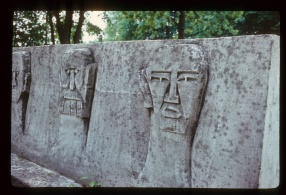Monuments
"A monument is an emanation of emotional and not practical energy" - this casual note found in the archive of the Władysław Hasior Gallery fully summarises the creator's philosophy. Hasior treated any form of artistic activity as preparatory studies to monumental spatial concepts for mass audience. He was interested in creating in a public area. "Notatniki" ["Notebooks"] collected here are one of the largest subsets. In the afore-mentioned archive you can find also a "Samochodowy Atlas Polski" ["Motorist's Atlas Poland"] with notes on journeys across the country and marked visited places or places to be visited. A part of notes - frequently photographic ones, e.g. in the form of postcards- notes - includes a name of the author of monumental concept, dates of erection of monuments, information about whether and when Hasior photographed the monument in nature. Separately, on pieces of paper Hasior wrote down names of contemporary monumental sculptures and their works which he deleted from the list after visiting. In the first published "Notatnik" ["Notebook"], i.e. a study on commemoration ("Nagrobki narodowej pamięci" ["Tombstones of National Memory"], "Odra" 1971, No. 6), Hasior writes that a monument is a certificate about the virtue and memory of it. This is to be a symbol of vivid values but it becomes a tombstone due to a low formal value of accomplishment and reproduction of "rooted conceptual patterns". In his studies on a history of monument and in his observations of contemporaneity Hasior relies on a synthesis of forms and particular photographic essays are comparative studies, frequently going beyond the frameworks assigned by particular titles. The exceptional collections include "Artyści na cokole" ["Artists on a Pedestal"].
The set includes "Notatniki" ["Notebooks"]: "Pomniki Architektoniczne" ["Architectural Monuments"] (109), "Pomniki" ["Monuments"] (130, 267, 268, 359), "Pomniki Różne" ["Miscellaneous Monuments" ](339), "Pomniki XIX wiek" ["Monuments - 19th Century"] (215), "Pomniki XIX wiek – Getto" ["Monuments - 19th Century - Ghetto"] (217), "Schematy" ["Patterns"] (271), "Schemat klocków Dunikowszczyzna" ["Pattern of Blocks - Dunikowski's Style"] (133), "Klocki" ["Blocks"] (138), "Pomniki Kominy" ["Monuments - Chimneys"] (132), "Schemat głowy w pomnikach" ["Pattern of Head in Monuments"] (114), "Postać w pomnikach polskich" ["A Figure in Polish Monuments"] (098, 113), "Postać w pomnikach" ["A Figure in Monuments"] (129), "Jęki w pomnikach polskich" ["Groans in Polish Monuments"] (110), "Artyści na cokole" ["Artists on a Pedestal"] (115), "Pomniki polskie" ["Polish Monuments"] (025, 026, 028, 030, 206), "Majdanek" ["Majdanek"] (122), "Majdanek Grunwald" ["Majdanek Grunwald"] (140), "Białystok pomnik" ["Białystok - Monument"] (134), "Pomnik Łódź" ["Monument - Łódź"] (144), "Pomniki radzieckie" ["Soviet Monuments"] (065), "Pomniki włoskie" ["Italian Monuments"] (154), "Pomniki Francja XIX wiek" ["Monuments - France - 19th Century"] (209), "Pomniki XIX wiek Węgry" ["Monuments - 19th Century - Hungary"] (210), "Pomniki Niemcy" ["Monuments - Germany"] (211), "Pomniki Jugosławia" ["Monuments - Yougoslavia"] (212), "Pomniki angielskie" ["English Monuments"] (213), "Pomniki Paryża" ["Monuments of Paris"] (214), "Belgia pomniki XIX wiek" ["Belgium - Monuments - 19th Century"] (216), "Azjatycki pomnik" ["Asian Monument"] (272), "Dawne pomniki ruskie" ["Ancient Russian Monuments"] (320), "Pomniki fińskie" ["Finnish Monuments"] (324).
Bibliography:
W. Hasior, Nagrobki narodowej pamięci [Tombstones of National Memory], "Odra" 1971, No. 6, pp. 43-50.
W. Hasior, Myśli o sztuce [Thoughts on Art], Nowy Sącz 1987.




